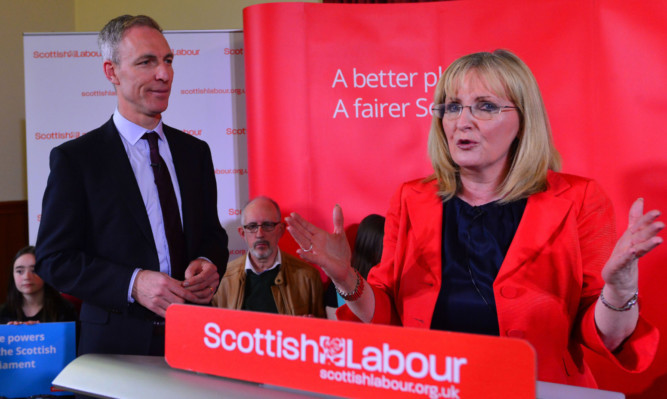The strains of the election campaign rose to the surface in the latest set-to between the Scottish party leaders.
The exchange, on BBC’s Sunday Politics, was shouty and bad tempered, with little constructive debate to help voters make up their minds.
This is politics, though, and what we’d expect with polling day in under a month and the bitter divide between separatists and unionists in Scotland still very much to the fore.
But away from the television studios, a far uglier spectacle is unfolding on the doorsteps of the most closely contested constituencies.
The Shadow Scottish Secretary, Margaret Curran, has been subjected to Nationalist thug tactics as she canvasses Glasgow East in a bid to be re-elected.
As was reported in a Sunday newspaper, she is being ‘hunted’ to use the SNP activists’ own term by a pair of Nationalist zealots, who film her and shout abuse as she talks to constituents.
The SNP candidate in the seat, Natalie McGarry, has defended her comrades’ actions as ‘community justice’, a sinister new phrase in the Nationalist lexicon, used to defend bully boy antics.
Curran is a seasoned campaigner and has withstood the cut and thrust of the Commons for five years, but voters who open their doors to the MP are also being targeted by the Nationalist agitators, as are other canvassers.
This is not electioneering in the accepted sense, whereby politicians try to unpick each other’s policies. This is an attack on people for holding the ‘wrong’ views and an attempt to coerce them into silence.
On Friday, the Labour and Conservative offices in Aberdeen were vandalised, the latter with a swastika and the letter ‘Q’ (after the Norwegian World War Two traitor Vidkun Quisling) an echo of last summer, when ‘No’ billboards from Perth to Dundee were defaced and destroyed.
Scots have not been able to escape the battle lines of the referendum during this general election, and the rules of engagement, as established by the furthest reaches of secessionist extremism, remain the same.
The bile of the cybernats, which came to dominate the run-up to last September’s ballot, was always suspected to be more than the work of a few disturbed mavericks, and recent episodes suggest there is indeed an SNP culture which encourages hate-fuelled rage against any opponents.
A young woman, Dawn Rodger, who voiced her support for the Scottish Labour leader Jim Murphy after one of the televised Scottish debates, was accused of being a Labour plant by the Nationalist MSP, Christine McKelvie. Miss Rodger said she had to deactivate her Facebook account afterwards, so bad was the abuse.
Such intolerance would shame a nascent democracy but in Scotland, birthplace of the Enlightenment, we have had to get used to it.
Visitors north of the border, however, are still shocked. Faisal Islam, Sky’s political editor, said an SNP supporter at a rally in Aberdeen in December had questioned his suitability to report on the event because he wasn’t Scottish.
Nicola Sturgeon is quick to condemn the racism in her ranks but this is by no means the first time that Scottish Nationalists have challenged people’s right to be in the country.
In 2012, the novelist Alasdair Gray accused Vicky Featherstone, then head of the National Theatre of Scotland, of being a ‘colonist’,
And even Scots returning home to work Andrew Marr, Jim Naughtie and Sarah Smith have been the victims of their secessionist countrymen’s fury for taking prominent BBC roles here. Faisal Islam’s colleague, Niall Paterson (a Scot), was called a quisling.
How can a party that purports to want increased immigration to Scotland justify these xenophobic outbursts?
There are elements of nationalism within the SNP that bear a grim similarity to historical nationalist movements in their anti-democratic conviction that they alone have the right to speak.
The more benign face of Scottish nationalism has managed to prevail just through tight party discipline and the remnants of an old guard uncomfortable with such nonsense.
But it is not enough for Sturgeon to distance herself from the frightening fringes of her party. She must confront the bullies and expel them if they are members; they darken not only the SNP’s reputation but Scotland’s.
